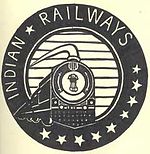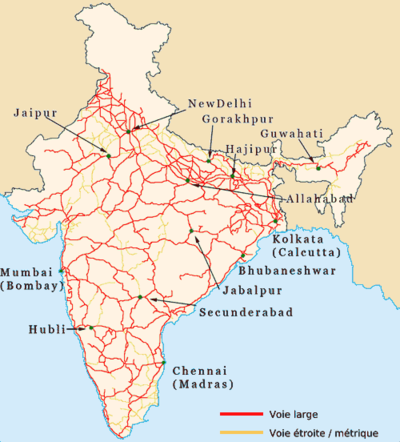- Indian Railways
-
Chemins de fer indiens
Indian Railways
Création 16 Avril 1853 Personnages clés Mamata Banerjee
(Ministre des chemins de fer)
E. Ahamed & K.H. Muniyappa (Ministres d'État)
Vivek Sahai
(Conseil ferrioviaire)[1]Forme juridique entreprise publique Siège social New Delhi Actionnaires La république de l'Inde (100%) Produits Transport ferrioviaire (passagers et marchandises), autres services Effectif 1.600.000 (2009) Site web www.indianrail.gov.in Chiffre d’affaires 19,17 milliards US$ (2009-10) Résultat net 206,37 millions US$ (2009-10) modifier 
Les Indian Railways (IR, « chemins de fer indiens ») désignent l'entreprise publique qui exploite le réseau ferroviaire de l'Inde. Elle est surveillée par le ministère des Chemins de fer du gouvernement de l’Inde.
L’entreprise possède le plus grand réseau ferroviaire en Asie. Elle transporte 20 millions de passagers et plus de 2 millions de tonnes de fret au quotidien. Elle est l’une des plus grands employeurs du monde, avec plus de 1,6 million d’employés. Les chemins de fer traversent la longueur et la largeur du pays, couvrant 6 909 stations avec plus de 63 300 kilomètres de rail. Quant aux matériels de transports, l’IR possède plus de 200 000 wagons de fret et 8 000 locomotives.
Les premiers chemins de fer en Inde date de 1853, conçus et construits par les Britanniques, pendant leur domination coloniale. En 1947, année de l’indépendance de l’Inde, il y avait 42 systèmes de rails. En 1951, les systèmes ont été nationalisés. En 2011, l’IR possède et exploite un réseau de voie large, de voie métrique et de voie étroite.
Sommaire
Histoire
La première ligne de chemin de fer en Inde est ouverte le 16 avril 1853 entre Bombay et Thane sur une distance de 21 miles, lorsque James Dalhousie était Gouverneur Général de l'Inde.
Caractéristiques
Le réseau indien est l'un des plus importants réseaux ferrés du monde tant par l'étendue que par son activité. Il transporte chaque année 4,2 milliards de voyageurs et plus de 300 millions de tonnes de marchandises sur 100 000 kilomètres de lignes.
Les chemins de fer indiens sont le premier employeur civil du monde avec un effectif de plus de 1,6 million de salariés permanents[2]
Les chemins de fer indiens sont directement rattachés au ministère des Chemins de fer.
Notes et références
- Railway Unit, Official webpage of Indian Railways. Consulté le 2009-06-06
- Par comparaison, en France l'Éducation nationale emploie 1,1 million de salariés
Voir aussi
Articles connexes
- India National Rail Museum
- Transport ferroviaire en Inde
- Kashmir Railway
- Gare de New Delhi
- Project Unigauge
Lien externe
Catégories :- Entreprise ferroviaire
- Entreprise indienne
- Transport ferroviaire en Inde
- Entreprise publique
Wikimedia Foundation. 2010.

